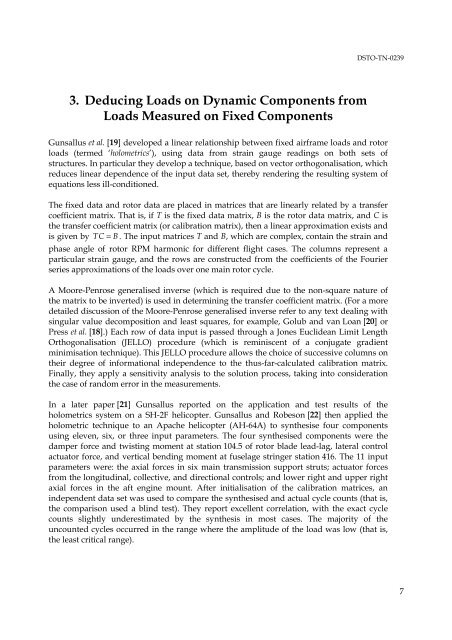Estimation of Structural Component Loads in Helicopters: A Review ...
Estimation of Structural Component Loads in Helicopters: A Review ...
Estimation of Structural Component Loads in Helicopters: A Review ...
Create successful ePaper yourself
Turn your PDF publications into a flip-book with our unique Google optimized e-Paper software.
DSTO-TN-02393. Deduc<strong>in</strong>g <strong>Loads</strong> on Dynamic <strong>Component</strong>s from<strong>Loads</strong> Measured on Fixed <strong>Component</strong>sGunsallus et al. [19] developed a l<strong>in</strong>ear relationship between fixed airframe loads and rotorloads (termed ‘holometrics’), us<strong>in</strong>g data from stra<strong>in</strong> gauge read<strong>in</strong>gs on both sets <strong>of</strong>structures. In particular they develop a technique, based on vector orthogonalisation, whichreduces l<strong>in</strong>ear dependence <strong>of</strong> the <strong>in</strong>put data set, thereby render<strong>in</strong>g the result<strong>in</strong>g system <strong>of</strong>equations less ill-conditioned.The fixed data and rotor data are placed <strong>in</strong> matrices that are l<strong>in</strong>early related by a transfercoefficient matrix. That is, if T is the fixed data matrix, B is the rotor data matrix, and C isthe transfer coefficient matrix (or calibration matrix), then a l<strong>in</strong>ear approximation exists andis given by T C = B . The <strong>in</strong>put matrices T and B, which are complex, conta<strong>in</strong> the stra<strong>in</strong> andphase angle <strong>of</strong> rotor RPM harmonic for different flight cases. The columns represent aparticular stra<strong>in</strong> gauge, and the rows are constructed from the coefficients <strong>of</strong> the Fourierseries approximations <strong>of</strong> the loads over one ma<strong>in</strong> rotor cycle.A Moore-Penrose generalised <strong>in</strong>verse (which is required due to the non-square nature <strong>of</strong>the matrix to be <strong>in</strong>verted) is used <strong>in</strong> determ<strong>in</strong><strong>in</strong>g the transfer coefficient matrix. (For a moredetailed discussion <strong>of</strong> the Moore-Penrose generalised <strong>in</strong>verse refer to any text deal<strong>in</strong>g withs<strong>in</strong>gular value decomposition and least squares, for example, Golub and van Loan [20] orPress et al. [18].) Each row <strong>of</strong> data <strong>in</strong>put is passed through a Jones Euclidean Limit LengthOrthogonalisation (JELLO) procedure (which is rem<strong>in</strong>iscent <strong>of</strong> a conjugate gradientm<strong>in</strong>imisation technique). This JELLO procedure allows the choice <strong>of</strong> successive columns ontheir degree <strong>of</strong> <strong>in</strong>formational <strong>in</strong>dependence to the thus-far-calculated calibration matrix.F<strong>in</strong>ally, they apply a sensitivity analysis to the solution process, tak<strong>in</strong>g <strong>in</strong>to considerationthe case <strong>of</strong> random error <strong>in</strong> the measurements.In a later paper [21] Gunsallus reported on the application and test results <strong>of</strong> theholometrics system on a SH-2F helicopter. Gunsallus and Robeson [22] then applied theholometric technique to an Apache helicopter (AH-64A) to synthesise four componentsus<strong>in</strong>g eleven, six, or three <strong>in</strong>put parameters. The four synthesised components were thedamper force and twist<strong>in</strong>g moment at station 104.5 <strong>of</strong> rotor blade lead-lag, lateral controlactuator force, and vertical bend<strong>in</strong>g moment at fuselage str<strong>in</strong>ger station 416. The 11 <strong>in</strong>putparameters were: the axial forces <strong>in</strong> six ma<strong>in</strong> transmission support struts; actuator forcesfrom the longitud<strong>in</strong>al, collective, and directional controls; and lower right and upper rightaxial forces <strong>in</strong> the aft eng<strong>in</strong>e mount. After <strong>in</strong>itialisation <strong>of</strong> the calibration matrices, an<strong>in</strong>dependent data set was used to compare the synthesised and actual cycle counts (that is,the comparison used a bl<strong>in</strong>d test). They report excellent correlation, with the exact cyclecounts slightly underestimated by the synthesis <strong>in</strong> most cases. The majority <strong>of</strong> theuncounted cycles occurred <strong>in</strong> the range where the amplitude <strong>of</strong> the load was low (that is,the least critical range).7
















